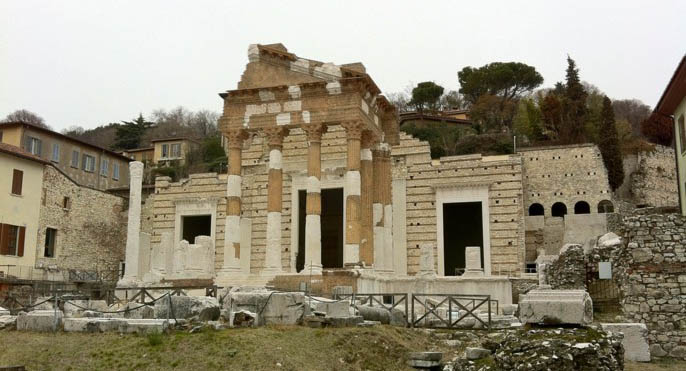
Roman Brescia is likely to be an unexpected pleasure for the visitor. Found right in the heart of the city is one of northern Italy’s most interesting archeological sites. Since the beginning of the 19th century public and private Roman buildings have been uncovered and restored to public view. Now visitor can see the impressive remains of the Forum, the Capitoline Temple, the Theatre, the Basilica as well as private houses with mosaics and frescoes (particularly impressive are the Domus del Ninfeo and the Domus dell’Ortaglia in the area of the Santa Giulia Monastery, now the City Museum).
In what is still called piazza del Foro (Forum Square) – the centre of Roman civil and religious life – the two main streets of the city crossed, the decumanus maximus (now via dei Musei) and the cardus (now via Agostino Gallo).
The Forum was finally finished in the Flavian Era between 69 and 96 A.D. To the north of the Forum stands the Capitolium (Capitoline Temple) built by Emperor Vespasian in 73 A.D.
The collections of treasures, once kept in the now closed Roman Civic Museum, have now moved and reorganized to the roman section of the new City Museum in the Monastery of Santa Giulia and San Salvatore. The most important item is the bronze Winged Victory, probably the best-known ancient sculpture in north Italy, but also important are six large gilded bronze heads from the Imperial era, found hidden between the Temple and the Cidnean Hill in 1826.
In the Lapidarium on the ground floor tablets, altars and architectural fragments are displayed. The central cella is interesting for its collection of inscriptions mounted on the walls around 1830 and includes reproductions of some of the most important walled tablets in public and private buildings in the city and its province. To the south of the Forum stands the 1st century A.D. Basilica whose remains are still visible embedded in the wall of a building in piazza Labus. Just behind the Forum, and set slightly back with respect to via dei Musei, is the Theatre which was built in the 3rd century A.D. Although it was seriously damaged in an earthquake in the 5th century, it was still used afterwards and public meetings were held there even in the Middle Ages. The Theatre was the third largest in northern Italy after Verona and Pola and could hold fifteen thousand spectators. Today, the cavea and parts of the stage can be seen.
Photo: Andrew Nash
